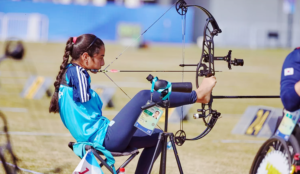Stronger butt (glutes) can reduce the risk of getting injured among athletes and sportspersons. Here’s how you can build up a better butt, as High Performance Coach Bram Swinnen from Belgium recommends:
The gluteal muscles or glutes are the largest muscles in our bodies. They are responsible for maintaining balance and power when we jump, walk, or run. These muscles play a crucial role in providing neuromuscular control of the lower extremity. Altered activation patterns of these muscles are a contributing factor for various lower extremity injuries.The glutes consist of three muscles: Gluteus Maximus, Gluteus medius and Gluteus minimus. Maximus is responsible for hip extension (when you are walking) and lateral rotation of the thigh (such as while swinging your leg). Medius is needed for the movement of the leg away from the body. Minimus is the smallest of the three muscles. It helps us in walking and rotation of the legs. According to experts, the gluteus maximus may also function as a knee stabiliser in addition to the hamstring muscles.
Why is it important to strengthen and train the glutes?
Introducing exercises into the workout, warm-up or activation session that target the gluteal muscles and re-establish correct muscle recruitment patterns can positively impact the lower-body strength and function, improve your core stability, prevent lower-body injuries and enhance athletic performance. People with low back pain often have weak and deconditioned glutes. Not only are the glutes the body’s largest and most powerful muscle group, but training them also helps one to improve posture, minimise back pain, and generate speed and power during exercise and athletic performances. Thus, it is very important to condition, strengthen and train the glutes with correct form of exercises.
What are the various injuries caused due to weak or inhibited gluteal muscles?
Hamstring strains : Due to delayed gluteus maximus activity, the hamstring muscles become dominant during hip extension, which can cause hamstring strains. A lot of athletes with pulled hamstrings keep suffering from re-injuries despite their focus and efforts to strengthen the hamstrings. The reason for the repeat injuries is that often they are reinforcing a compensation pattern instead of reactivating their inhibited glutes. Speaking about the same, expert Shirley Sahrmannsaid: “Any time you see an injured muscle, look for a weak synergist.”
Low back pain : Gluteus maximus activation plays an important role in stabilising the pelvis during the task of lifting. Delayed gluteus maximus activation also causes excessive compensation of the back extensors.
Anterior knee pain : The excessive internal rotation of the femur as a result of gluteal weakness increases the pressure on the patellar cartilage.
Anterior hip pain : Decreased force production from the gluteus maximus during hip extension is associated with increased anterior translation of the femur in the acetabulum. The increased femoral anterior glide could lead to increased force and wear and tear on the anterior hip joint structures.
Lower-body misalignment : Weak glutes results in increased internal rotation of the femur, knee valgus and foot pronation.
Gluteal weakness : also has been associated with anterior cruciate ligament (ACL) sprains, chronic ankle instability and Iliotibial friction syndrome.
Exercises to re-activate the gluteal muscles
Re-activation of the gluteal muscles can re-establish correct muscle recruitment patterns and enhance strength and performance. Because of compensatory patterns it may be difficult to target and strengthen the glutes. Exercises that require single-leg balance, stability of the lumbo-pelvic region, hip extension or eccentric control of hip flexion, which are all major functions of the gluteus maximus, result in the greatest level of activation. Here are some excercises that can be practiced to strengthen the glutes:
1. Resisted slide-board back lunge
In the resisted slide-board back lunge, the pull of the cable creates a hip flexion force against which the gluteus maximus has to stabilise. The movement also mimics the hip action of running and stair climbing. Like in running, the body has to be pulled over the foot by a powerful hip extension.

2. Overhead slide-board back lunge
As an advanced progression, the exercise can be combined with holding a barbell overhead. This overhead slide-board back lunge emphasises on the stabilising role of the gluteus maximus even more. Overhead exercises require anti-flexion stability from the core. The co- contraction of the gluteus maximus and deeper trunk muscles stabilise the spine, so forces can be effectively transferred from the lower to the upper body.

3. Single-leg squat & single-leg Romanian deadlift
Other exercises that elicit a high gluteus maximus and medius activity are the single-leg squat and the single-leg Romanian deadlift. These single-leg exercises require concentric or eccentric hip extension throughout a large range of motion. The need to stabilise the hip in the frontal portion (resisting gravity’s hip adduction torque) and transverse plane (preventing internal rotation of the thigh) while generating movement in the frontal plane (concentric/eccentric hip extension) results in a high neural drive of the gluteus maximus, medius and minimus.
In the single-leg squat and pull and the single-leg Romanian deadlift and pull, the hand opposite to the stance leg is loaded. The added rotary force stimulates the external rotator capability of the gluteus maximus and medius and gives these exercises a multi-planar character. These exercises also train the cross-body connection (posterior oblique system), which transmits forces from the ground through the leg and hip, across the sacroiliac joint via the thoracolumbar fascia, into the opposite lattisimus dorsi.






